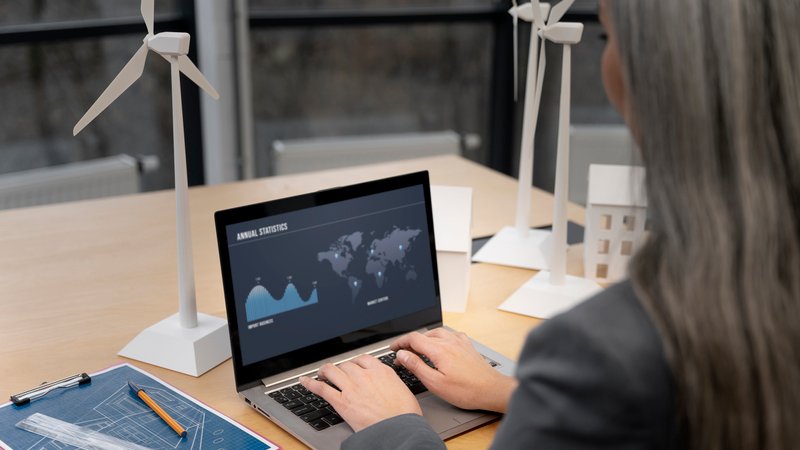Wind energy has become one of the fastest-growing renewable energy sources globally. As the world transitions toward sustainable energy solutions, wind power plays a crucial role in reducing greenhouse gas emissions and promoting energy independence. Moreover, advances in technology have significantly improved the efficiency, reliability, and affordability of wind energy. In this article, we will explore the key technologies used in harnessing wind energy.
1. Wind Turbines
At the core of wind energy generation are wind turbines, which convert kinetic energy from the wind into mechanical energy and then into electricity. There are two main types of wind turbines:
a. Horizontal-Axis Wind Turbines (HAWTs)
These are the most common types of wind turbines, characterized by their large rotor blades that spin on a horizontal axis. HAWTs are typically used in large wind farms and offshore wind projects. Some of the key components of HAWTs include:
- Rotor Blades: Capture wind energy and convert it into rotational motion.
- Nacelle: Houses the generator, gearbox, and other essential components.
- Tower: Provides height to capture stronger winds at higher altitudes.
b. Vertical-Axis Wind Turbines (VAWTs)
On the other hand, vertical-axis wind turbines have blades that rotate around a vertical axis, making them suitable for urban environments and areas with unpredictable wind patterns. They are easier to maintain; however, they generally produce less power compared to HAWTs.
2. Wind Turbine Components and Technologies
Several technological advancements have improved the performance of wind turbines, making them more efficient and reliable. Some key components and technologies include:
a. Advanced Rotor Blade Design
To begin with, modern rotor blades are designed using lightweight materials such as carbon fiber and composites to maximize efficiency. Additionally, aerodynamic optimization and computational fluid dynamics (CFD) simulations help improve blade performance and durability.
b. Gearbox and Direct-Drive Systems
In traditional wind turbines, the gearbox increases the rotational speed of the rotor blades to generate electricity efficiently. However, direct-drive systems, which eliminate the need for a gearbox, are gaining popularity due to their lower maintenance requirements and higher reliability.
c. Smart Sensors and Monitoring Systems
Furthermore, advanced sensors and Internet of Things (IoT) technology are used to monitor the performance of wind turbines in real-time. These systems collect data on wind speed, temperature, and vibration, enabling predictive maintenance and reducing downtime.
3. Offshore Wind Energy Technology
Offshore wind farms are becoming increasingly popular due to their ability to harness stronger and more consistent winds. Specifically, specialized technologies used in offshore wind energy include:
a. Floating Wind Turbines
Unlike traditional fixed-bottom offshore turbines, floating turbines are anchored to the seabed using mooring systems. Consequently, this allows them to be deployed in deeper waters where wind speeds are higher.
b. Subsea Cable Technology
Moreover, subsea cables are used to transmit the electricity generated by offshore wind farms to the mainland grid. Advanced high-voltage direct current (HVDC) cables help minimize energy losses over long distances.
4. Energy Storage Solutions
Since wind energy is intermittent, effective energy storage solutions are crucial to ensuring a stable power supply. Some commonly used storage technologies include:
a. Battery Storage Systems
First and foremost, lithium-ion and other advanced batteries store excess electricity generated during high wind periods for use when wind speeds are low.
b. Pumped Hydro Storage
Similarly, this involves using excess wind energy to pump water to a higher elevation, which can later be released to generate hydroelectric power when needed.
c. Hydrogen Production
Additionally, wind energy can be used to produce green hydrogen through electrolysis, providing a clean fuel source for various applications.
5. Grid Integration and Control Systems
Integrating wind power into existing electricity grids requires advanced control systems and grid-balancing technologies. Some key advancements in this area include:
a. Smart Grids
Notably, smart grid technology enables better management of fluctuating wind energy supply by dynamically adjusting demand and optimizing power distribution.
b. Power Electronics
Furthermore, modern inverters and converters help stabilize the frequency and voltage of electricity generated by wind turbines, ensuring compatibility with the grid.
6. Wind Resource Assessment Tools
Accurate wind resource assessment is crucial for identifying suitable locations for wind farms. Technologies used for wind assessment include:
a. LiDAR (Light Detection and Ranging)
LiDAR technology measures wind speed and direction at various altitudes, helping developers select optimal sites for wind energy projects.
b. Computational Models
Likewise, advanced software tools use meteorological data and terrain analysis to predict wind energy potential and optimize turbine placement.
Conclusion
In conclusion, the technology used for wind energy has evolved significantly, making it one of the most viable and sustainable energy sources available today. From advanced turbine designs and offshore innovations to energy storage and grid integration solutions, technological advancements continue to drive the growth and efficiency of wind energy. As research and development efforts continue, wind power is expected to play an even greater role in the global transition to clean energy.
For more info BBC BLOG
